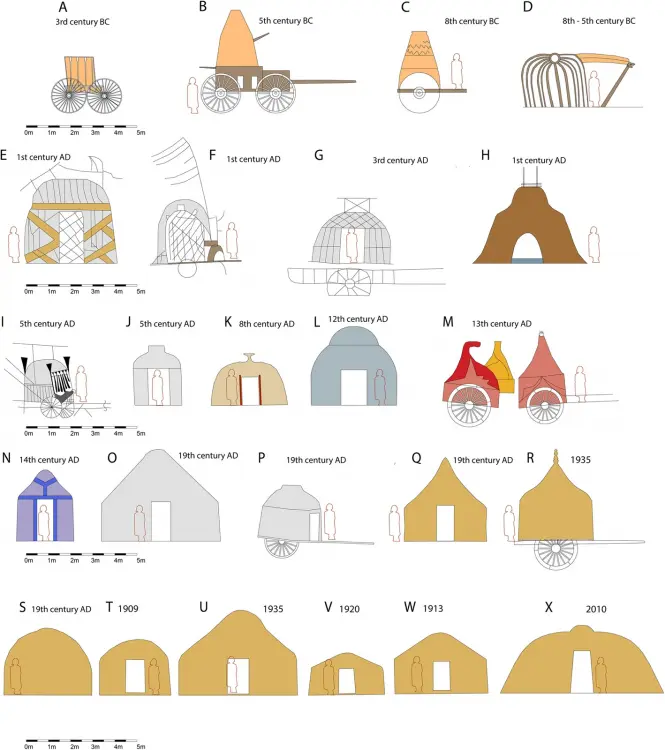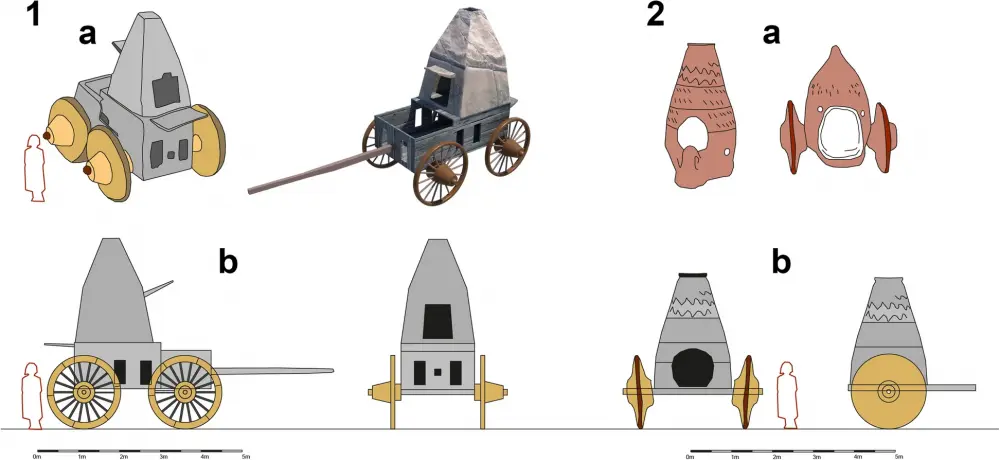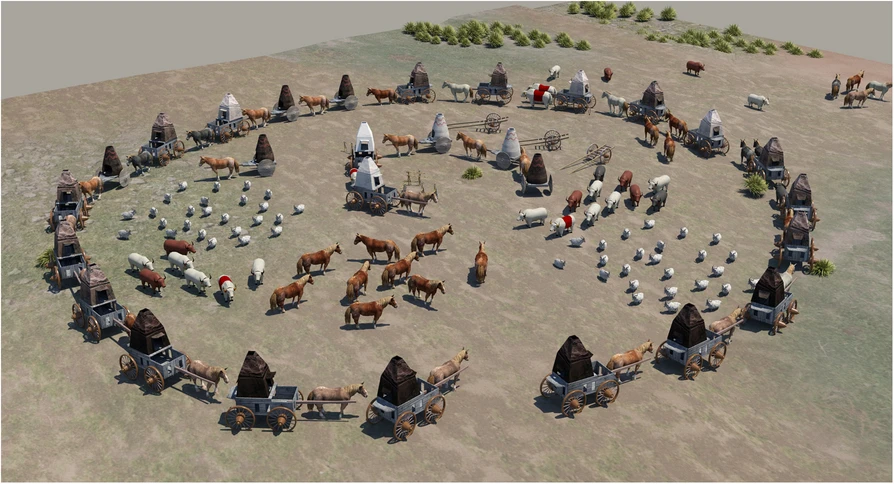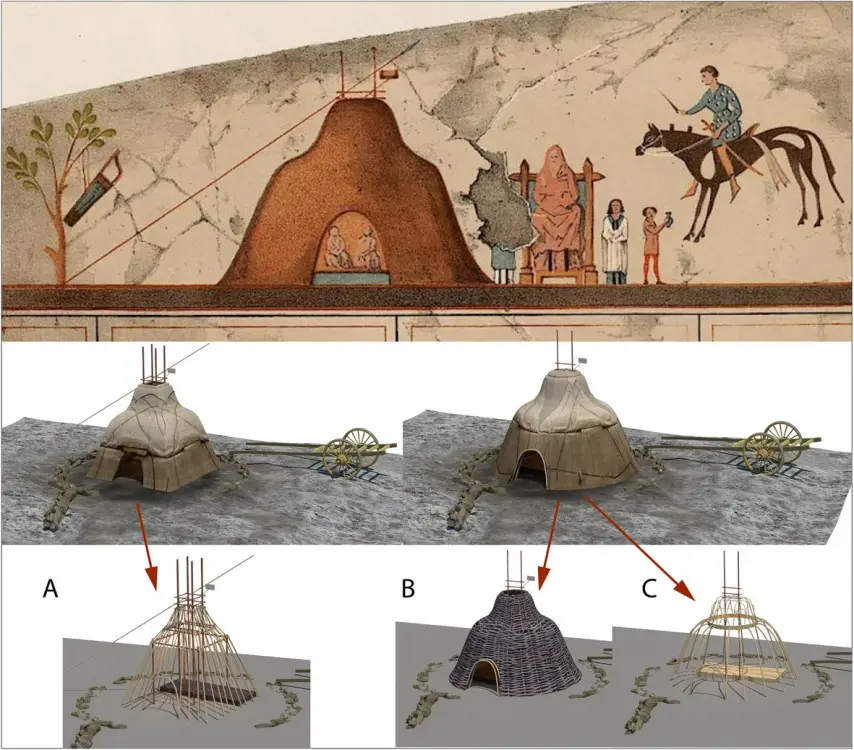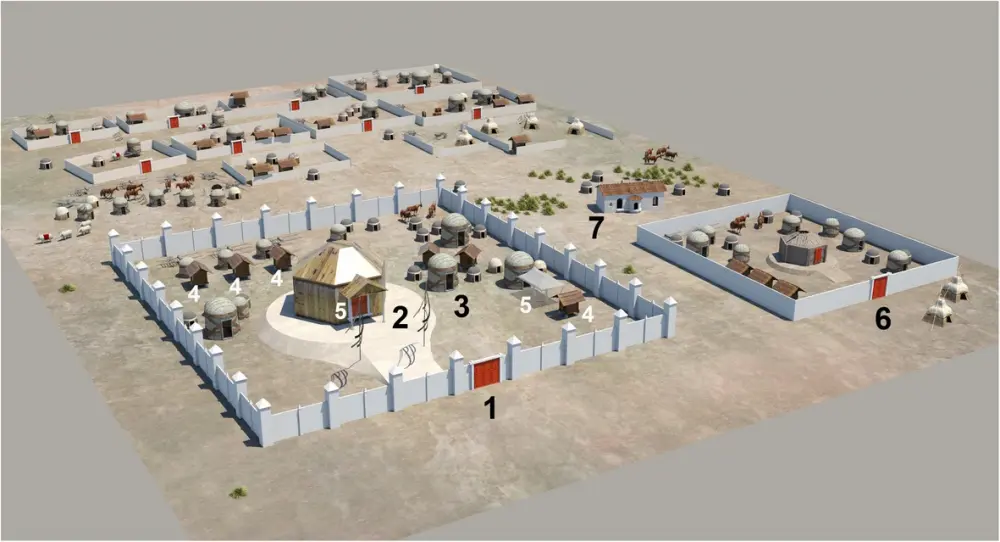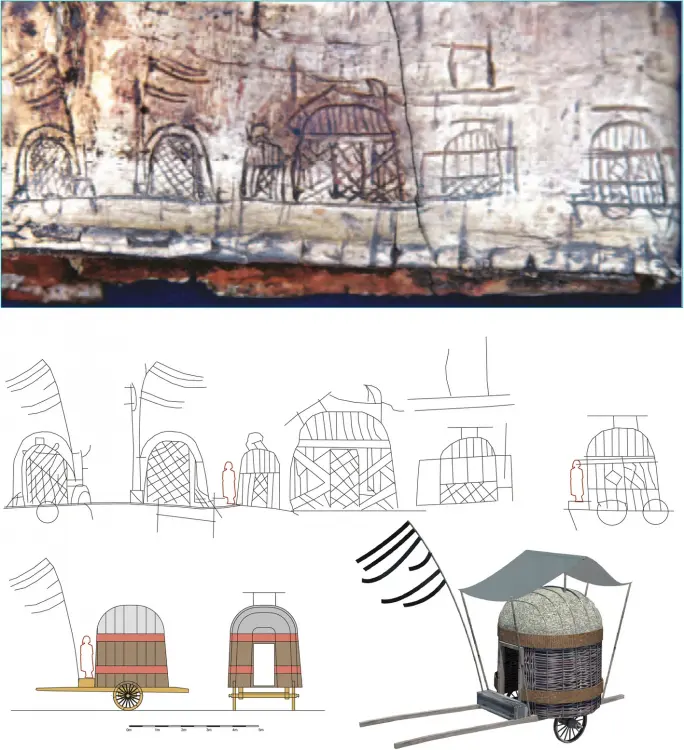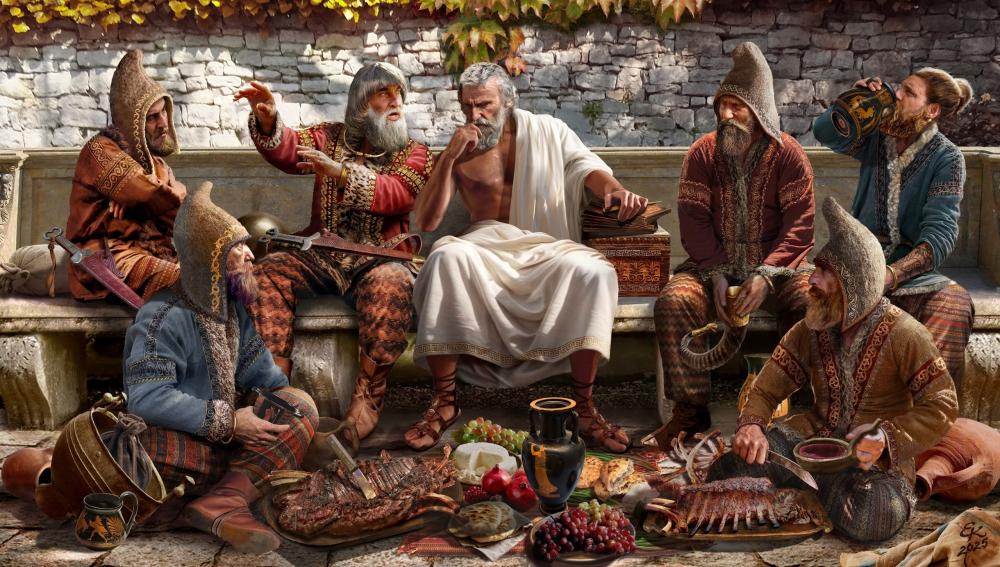All Activity
- Past hour
-
I think we can make a new prop to go on the back of the wagon cart that looks like this. The cones sticking out from the wheels over the hubs would make for a nice little detail too.
-
https://built-heritage.springeropen.com/articles/10.1186/s43238-025-00191-2 Inner Asian and Eurasian nomadic camps comprise different types of guyed tents, mobile wood-framed dwellings and carts of various forms. One of the first available depictions originated from the Arjan Bowl, which was found in an Elamite grave in Iran and was dated 800–500 BCE (Majidzadeh 1992). It shows a rib tent (which would be dismantled for transport) with struts and a roof hoop (Fig. 3-D). Greek sources mention Scythian nomads residing in carts, e.g., Hesiod (eighth century BCE), in which Phineus is carried by the Harpies ‘to the land of the men who live on milk and who have their home in wagons’ (Hesiod, The Poems and Fragments (1908, 89, frag. 54). Aeschylus (525–456 BCE) mentioned ‘wattled dwellings, poised high on true wheeled carts’ (Aeschylus 1922, i, 278–279; Andrews (1999, 14) interpreted this passage as indicating that the dwellings were made of a frame woven from twigs or sticks (probably from willow), which was then fixed to the cart and covered by felt. The latter fact was noted by Hippocrates (ca. 460 to ca 377 BCE): Comparison of the shapes and sizes of tents and tent carts from historical finds, depictions or photographs. All tents are scaled to the same size (as far as it was possible to determine the exact size). A Pazyrik cart, real find; (B-C) after clay models; (D) rib tent from the Arjan Bowl; (E-F) Xiongnu carts, birch-bark container in Tsaram; (G) Xiongnu carts, Shancheng coffin painting; (H) Sarmatian tent, tomb of Anthesterius, Crimea; (I) cart from a Tuoba coffin in Datong; (J) Tuoba tent from a grave in Datong; (K) Tibetan tent from a coffin painting in Delingha, Qinghai; (L) Khitan tent from the Wen-Chi scrolls; (M) Cuman carts, Radziwill chronicle; (N) Genghis Khan´s tent, Persian miniature; (O) Kalmyk, 1806 Bertuch Bilderbuch für Kinder; (P) Nogay cart, engraving; (Q) Turkoman tent in Afghanistan, drawing by William Simpson; (R) Chomchugh, refer to the text and Andrews (1999); (S) Kyrgyz kibitka (yurt) drawn by painter Vasily Vereschagin; (T) Avsar tent in Kayseri, photo by Gertrude Bell; (U) Kazakh tent, photo by Owen Lattimore; (V) Mongol yurt/tent, photo from the 1920s; (W) Mongol yurt/tent near Kalgan, photo by Stéphane Passet (1913); (X) Shasavan rib tent, Mount Sabalan, photo obtained in 2010 ‘There too live Scythians who are called nomads because they have no houses but live in wagons. The smallest wagons have four wheels, others six wheels. They are covered with felt and are constructed like houses, sometimes in two compartments and sometimes in three, which are proof against rain, snow, and wind’ [refer to Hippocrates Vol I, De Aere xviii, translated by Jones (1923, 119)]. Models of four-wheeled wagons with tent-like superstructures dated to 600 BCE were found in Kerch in East Crimea. These were made of clay with small windows in their lower structure. The author´s reconstruction is based on such a clay wagon mock-up (Figs. 4, 5). Hippocrates also stated that women and children lived in carts, whereas men spent most of their time on horseback and tended to flock. No depictions of Scythian dwellings (apart from clay models) have been discovered, although in the Pazyrik Kurgan (third century BCE), a complete wooden ceremonial wagon was found. The wagon was preserved exceptionally well and is now on display in the Ermitage in Moscow. Reconstructions (1-2 b) of a Scythian wagon (1) and Mingachevir cart (2) drawn by the author after clay models (1-2 a) Reconstruction of a Scythian wagon camp The first suggestion of tents that represent separate entities and are not part of carts is given with respect to Sarmatians. Strabo (53 BCE to ca. 21 CE) reported, ‘As for the nomads, their tents, made of felt, are fastened on the wagons in which they spend their lives, and round about the tents are the herds which afford the milk, cheese and meat on which they live, and they follow the grazing herd, from time to time moving to other places that have grass…’ (Strabo 1960), vii, 3, 17). Whether these tents fastened to carts were frequently removed and placed on the ground, as the tent components of tent carts in later times would have been, is unclear. There is only one known depiction of a Sarmatian tent, which is set on the ground. It was depicted in a wall painting in a grave chamber in Kerch on the Crimea Peninsula. Unfortunately, it does not exist anymore. Relevant documentation can be found in Minns; Wajnstein (1996) attempted a rectangular reconstruction of the tent. In this work, the author aimed to reconstruct rectangular and round variants, as no definitive hint regarding the ground plan is given in the depiction (Fig. 6). A structural system was also reconstructed, with the following options: A: rectangular variant, 4-post inner structure; B: round variant, woven/wattled structure; C: round variant, rib-tent structure. Depictions of a Sarmatian tent on a wall painting in Crimea (Source: Minns 1913). Shown below are reconstruction possibilities (Source: the author). It is possible to reconstruct the shape as a rectangular (A) or a round tent. For the round variant, a woven/wattled structure (B) or a rib-tent structure with a roof hoop (C) is possible According to Priscus of Panium, who was a diplomatic envoy and therefore eye-witness of the camp of Attila the Hun, Attila’s wife Hereka lived in a circular building with a wooden frame covered in skins or leather. This passage is the only reference in which Hunnic dwellings are described as circular and possessing a wooden frame. However, this passage has been debated as the text is not clear, but recent work (Carolla 2019) supports both the circular shape and skin/leather covering. Elsewhere in the text, Hunnic buildings are described as huts (Greek: kalube), which indicates that they are semipermanent buildings. Alternatively, although they comprise a wooden frame, they could be covered with reeds (mats) or similar material (but not felt or skins). However, no indication of their shape is given. Later, sixth-century Greek emissaries to the Western Turk ruler also described framed tents as huts (kalube) (Andrews 1999). Thus, it is not completely clear what type of building or tent (?) Priscus had observed. The building of Attila was described as being made of wood, but again, no definite indication of the ground plan form was given, only of its material (‘it had been fitted together with highly polished timbers and boards’ (Priscus of Panium in Gordon 1960, 84). The dwelling of Hereka is described as follows: ‘Inside the wall [of the compound of Attila], there was a big cluster of buildings, some made of planks carved and fitted together for ornamental effect, … the other [houses were made] of leather polished and cut straight/upright, put into some wooden circular basis. I gained entrance through the barbarians at the door and came upon her lying on a soft spread. The floor was covered with mats of felted wool’ (Priscus of Panium trans. Carolla 2019). Please also refer to Fig. 7. The extensive use of felt inside Hereka’s dwelling indicates a nomadic building context in any case. The custom to cover trellis tents in skins or furs and not felt exists ina nomadic historical context, e.g., there is a trellis tent of the Mongolian Bogd Khan from the 19th century covered in snow leopard skins (furs) on display in the Winter Palace of the Bogd Khan in Ulaan Bataar. Highly hypothetical drawing containing all the elements mentioned by Priscus of Panium, as observed by him in Attila’s capital during the fiveth century. 1, Attila’s compound with gate doors and wooden palisade with towers; 2, Attila’s dining hall/house at an elevated location; 3, Hereka’s tent; 4, buildings made of carved wood; 5, porticoes; 6, Onegesius' compound with a wooden enclosure without towers; 7, Roman bath built of stone by a captive architect from Syrmium In East Asia, there are several depictions of Xiongnu dwellings from the first century. To date, three scratched drawings/decorations of birch-bark containers show Xiongnu dwellings. These depictions all show the same dwelling type (Fig. 8): a round, domed hut with walls made of diagonally crossing lines (probably twigs or sticks). In some cases, this diagonally crossing structure extends to form the dome of the building. The dwelling comprises vertical walls, which, in every case, terminate in a horizontal band spanning the whole dwelling (a textile band holding the hut together, as in the case of modern trellis tents?). If there is a drawn door, it also reaches this horizontal band. The dome is often covered with what seem to be vertical stripes of different materials. At times, the walls are additionally wrapped with crosswise textile bands, and the walls can contain windows. An opening at the apex of the dome-like roof is not shown in any depiction (But its presence cannot be ruled out either). There are always two vertical sticks connected by a horizontal stick above the roof. The function of this construction is described later and is very similar to that in Tuoba Xianbei depictions (Fig. 9): very likely, an awning spanned above the dwelling to shade it (However, there is no Xiognu depiction were we actually can see such an awning in the drawing itself). The dwellings are often shown placed on carts. Moreover, the cart wheels encompass spokes, and the cart type is a two-wheeled cart. Written sources support the conclusions drawn from the images: The Xiongnu also employed ‘domed huts for homes’ (Huan 1994, 38) and ‘woven branches to make houses’ (Huan 1994, 52; Miller 2012). Depictions of Xiongnu carts found on a birch-bark container in Tsaram (after Minyaev (2009). Shown below is a line drawing of the scratchings and a reconstruction by the author. The awning above the cart was added as an analogy from fifth-century Tuoba Xianbei cart depictions Tuoba Xianbei cart depictions from coffin planks from Zhijiapu (Source: Liu and Gao 2005) @wowgetoffyourcellphone@Lopess I highly recommend to read the entire article.
- Today
-
-
Right. Standard construction still requires own territory, but the buildings don't decay if cutoff from a root. The only thing that bypasses this is when you convert an Ox Cart to a house or storehouse in neutral territory. It's a nod to nomadism that doesn't completely remove the territory dynamic.
-
Has Building capture been eliminated in A27
Grautvornix replied to Old Roman's topic in General Discussion
It definitely works. -
They don't require territory roots after they are built right? You can still only build in own territory?
-
Michaelbliva joined the community
-
I've been working on the Scythians a lot lately for DE (and eventual inclusion on EA. R29?). Ported over a few assets from Endovelico. Made some actor and mesh improvements, rethought a few things, etc. An updated direction for the Market. This is just a mockup, but easily accomplished: Their "Academy" (Imperial Academy/Syssiton/Gymnaseion) structure, the Royal Yurt. Trains champions and heroes: Stable, by @Duileoga: Corral: Ovoo: Thoughts: Google Translate now has the Ossetian language, which is the closest living language to Ancient Scythian. Let's leverage Ossetian for SpecificNaming. Nomadism Buildings auto-build, but have -50% health and capture points. While they are easier to destroy or capture, they also don't capture decay in neutral territory (they don't require territory roots). Receive special Ox Carts which are mobile resource dropsites (like the German ones) but can also transform into Houses and Storehouses at-will (and back) in own/allied/neutral territory. The Civic Center +25% territory influence radius (a great bonus), but its weight is -50% less than normal (their borders push much less against enemy borders than other civs do). Scythian Commoners (their Citizen-Civilians) have a range attack (use bows instead of knives) and an attack bonus vs. fauna. These traits can go to any nomadic civilization we may include, such as Xiongnu or Huns. Pastoralism Corral technologies research instantly. Receive a special Corral technology: Extensive Husbandry (boosts ranching) Receive a special Corral technology: Falconry (boosts Cavalry vision range and hunting) Raiders and Plunderers Scythian Maiden Huntresses +500% (TBD) loot while killing enemy units or destroying enemy buildings. These units are glass cannons, but if used right can more than pay for themselves in loot gained before they are killed. Scythian Buildings and Units only give half-loot when killed. Winds of the Steppe A team bonus for Cavalry or Stables or both. The cult of Scythian Ares The Scythian Ovoos are their primary territory pushers. No other structures besides Civic Centers and the Fortress (see below) have territory radius effects. The Ovoo also has an aura that boosts soldier attacks ("Sword of Ares") and Priestess stats ("Cult of Ares"). Scythian Priestesses can also pray here to get resources (TBD). Ovoos cost stone and metal and are very very tough and uncapturable (must be destroyed). Eventually we can create a new model which is the wooden platform with the sword at the top as described in the Histories. Maybe we can change the cost to Wood and Metal then, or give the Scythians the option to build either the stone ovoo or the wooden platform. Fortress The Scythians do receive a stone Fortress structure, but it's treated like a special building in that only 1 may be built. It becomes available in Town Phase. It has a territory radius, but functions more like a hard point for defense or offensive push, more typical of a redoubt. Fortress units (Champions and Heroes) are moved to the Royal Yurt (see image above, information below) as well as standard Fortress techs. The Fortress does get to train the Scythian Battering Ram in Town Phase and research the ram's relevant siege technologies. Royal Yurt Their "Academy" type structure, similar to the Spartan Syssition, the Han Imperial Academy, and or the Athenian Gymnasium in that it trains Champions and Heroes and researches relevant techs. It's also given the standard Fortress techs, such as Espionage and Will to Fight. Can invent a Special Tech for here. Maybe "Cavalry Tradition" or a special rank promotion tech applicable only to Cavalry. Technologies A special Forge technology: Goldsmithing (a boost to Market/Trading). The only Forge tech in the game with a specific economic effect. A special Forge technology: Composite Bows (boosts infantry and cavalry archers specifically). Replaces the final melee attack tech. They receive Archery Tradition like the Persians. Most technologies, except those in the Civic Center, take 25% longer to research or cost 20% more (TBD). I think something like I outlined (the exact values of things open for balance and design) keeps the core territory gameplay of 0 A.D., but adds enough distinctive features to make them feel a lot different than the other more "sedentary" civilizations. For DE specifically, I'll differentiate them even more with Cult Statues, Scouts, Cavalry are builders etc. But for EA I think what I've outlined is more than enough. What think?
-
-
Gregory Crum joined the community
-
Has Building capture been eliminated in A27
Grautvornix replied to Old Roman's topic in General Discussion
Oh, as fas as I remember, it used to work, but with the latest release I am not sure anymore. (For the AI it does work, I believe). Will try! -
-
What was happening was that I was loading an old save when I would make changes for debugging purposes. However, the old save would load data incorrectly if something had changed, causing certain details to not be present, like unit lists on structures, language types for vocals, etc.; it worked perfectly once I started a new match or used the simulate feature in the map editor, which is what I've been doing now. Essentially, what I learned was, don't change details about a unit, or structure, and then load a previous save with that structure or unit from an older version of the mod. it will not auto-update with the newest changes.
-
Has Building capture been eliminated in A27
LienRag replied to Old Roman's topic in General Discussion
I was never able to capture a dock, though. -
Rajko quit midgame when he was in a very bad position my username: LordVaibhav Opponent: Rajkocommands.txt
-
LordVaibhav joined the community
-

Scroll to change batch number not working
AlexHerbert replied to AlexHerbert's topic in Help & Feedback
The thing is the scroll works for other things like zoom... -

Scroll to change batch number not working
hyperion replied to AlexHerbert's topic in Help & Feedback
Maybe you have enabled macmouse option, the one to be used with those one button mice. -
-
Hello, I need a bit of help. I have seen player that can change the size of the batch is about to produce pressing shift and scrolling. I can do it in my Mac with the trackpad, shift + 2 fingers up/down, but it doesn't work for me with the mouse wheel. I was trying a tool called Hammerspoon and placed a couple of scripts but I couldn't get it work. Someone knows what's going on? Thanks beforehand
- Yesterday
-
That the installer just installs their version x in their path, with a working shortcut etc., and not care if there are other versions installed or not. I think other games like Battle for Wesnoth do it like that. Of course I'm assuming that this restrictive behavior is just legacy and can be disposed of.
-
Dual 0ad installation on Windows
Classic-Burger replied to guerringuerrin's topic in Help & Feedback
What do you propose? What would you remove or what would you add? -
Joining the lobby should be possible from anywhere, unless your country blocks it. Joining someone's match on the other end is another matter. The only solution would be dedicated servers you can join, and that requires money.
- 1 reply
-
- 1
-

-
It should though... Mods should install next to public if thats passed.
-
P.S. I am aware of the option ' pyrogenesis.exe -writableRoot" to store runtime game data in root data directory, but this is not it in full.
-
It does work, but indeed, a more flexible way of installing everything into the same directory (including mods, logs, maps, etc.) would be nice, so that one can have various independent versions if desired.
-
It’s probably an issue with a public IP or port settings. I really hope that in the future the game will be released on Steam with proper, fully functional multiplayer for everyone, because after a year and a half my friends and I came back to 0 A.D. and once again found ourselves trying to figure out how to join the lobby — using VPNs, Radmin, and other tools just to play normally, which doesn’t really help.
-
Latest Topics


.thumb.jpg.b21ca1d0c15fb56b42c39b25a0a40815.jpg)
